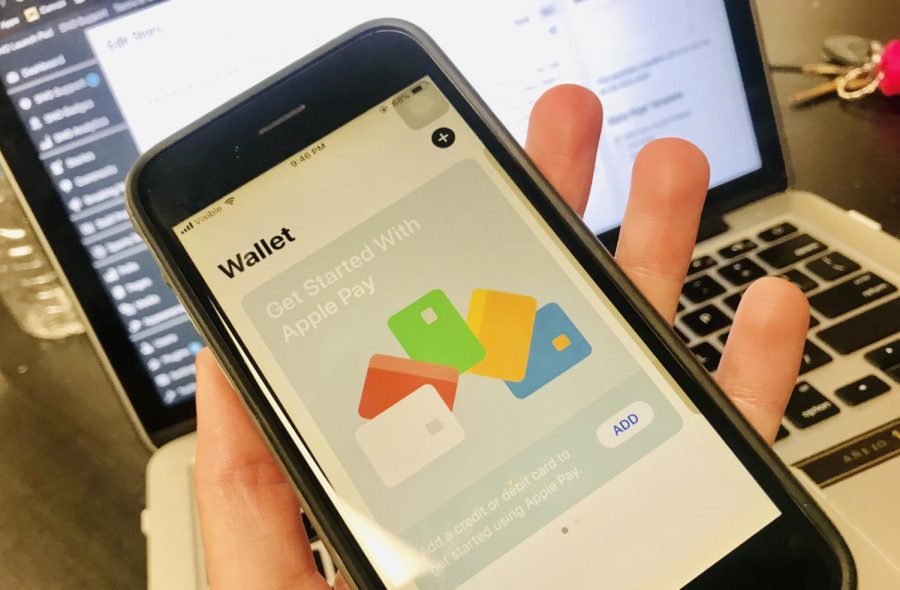The Apple Card, destined for success
September 26, 2019
Of the slew of products unveiled by Apple in the past few weeks (including the hushed iPhone 11), the one that intrigued me the most was a credit card. Apple card, a physical extension of Apple Pay rather than a real credit card, is a white titanium slab consisting of no numbers or expiration date – only your name and the Apple logo. Apart from small occurrences of discoloration, it has received an overall positive reception, with some tech critics even calling it as a massive game-changer. Its appeal, however, is a function of convenience and incentive rather than design.
The reason for saying the above is three-fold. First, Apple has been slowly and subtly trying to convert their revenue stream from hardware to software. Consider for example: Apple Music and Apple News, two popular services provided by Apple. These services are nothing new since they have been around for a long time, only marketed under different long-tail placeholders: iTunes and News.
The recent grand segregation was a result of an observation: individual standalone competitors quadrupling their revenue against extraordinary margins. In fact, it was exactly this that prompted companies like Spotify to go public.
Second, the array of subscription services that Apple markets are dynamic, and giving loyal consumers a physical card to pay for these subscriptions is just the cherry on top. Through this, Apple can give discounts to services they intend to launch in the future, tailored to these premium consumers beforehand with the hope they will to buy into it.
Lastly, the card doesn’t come without benefits. Apple is offering incentives worth as high as 3 percent for some of the Apple Pay supported services like movie tickets (bought through apps) and online bill payments. However, when used as a regular credit card, it can only yield up to 1% in returns; Apple clearly wants consumers to use the internet for making any type of payment. Given all this, it would be pessimistic to say that the card is a flop since the world is not ready to go cashless, let alone using only mobile apps for payments.
Apple has repeatedly shunned predictions by introducing revolutionary gadgets that replaced their own line of top-performers such as the iPod, iPad, and iPhone. But it is also a known fact that we are reaching a saturation point when it comes to hardware. Mobile phones sales are declining and Apple is growing desperate to come up with its next innovation.
In this whirlwind of uncertainties, Apple is placing its bet on a credit card that is approved by Goldman Sachs and accepted (or supported) by almost 65% of all U.S retail locations. Apart from the ease of use (which is Apple’s cardinal selling point), there are many things to admire about the card.
“For example, one interesting thing about it is that it attempts to add transparency to transactions,” writes David Pierce for The Wall Street Journal.
A transaction that took place at Walgreens will be displayed as “Walgreens on Front Store” along with the phone number, as opposed to showing something meaningless such as the transaction number or currency difference. Monthly bank statements are slowly being replaced by on the fly notifications of relevance.
The other thing to like about the card is that the app summarizes expenses made on the card and categorizes them by day, type, and merchant, so that consumers can track where their money is going. The Wall Street Journal further states that it is a, “great budgeting tool and facilitates payment of bills along with a feature that allows visualisation of the type of expenses and categories of pending bills.”
All in all, it is definitely a great alternative to other payment apps that fail to invade the credit card territory. Encompassing verticals like privacy, financial health, budgeting, it is clearly worth giving a shot.
However, the obvious drawbacks of a new credit card is foregoing rewards that could have accumulated otherwise. Airline companies, hotel chains, and big businesses (especially those that are heavily supported by holiday and discount retail) market their credit cards only as a long tail strategy to urge consumers to keep coming back. Apple Card will surely be, not only a test of their loyalty, but also a warning of how volatile trends are becoming. Many big brands like Forever 21 are already teetering on the brink of bankruptcy and a development that further shrinks their revenue even by a small margin is going to be a big hit on their growth outlook.
Finally at a time when software is becoming omnipresent and emerging as a multi-faceted bedrock of non-technical industries, Apple continues to leverage its brand equity to dominate hardware commodities. Exploring software services as a potential revenue path should be welcomed. However, only time will tell whether such a strategy pays off, or a credit card like this ends up as the next Apple Maps.
